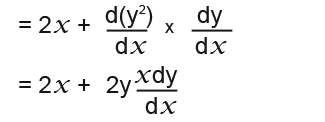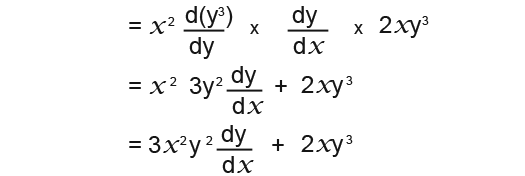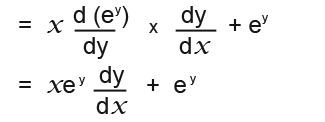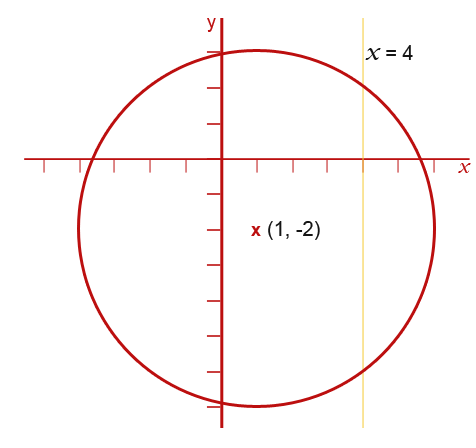Implicit differentiation
This chapter explores implicit differentiation. The chapter covers differentiating a function defined implicitly; Finding equations of tangents and normals to curves defined implicitly. Before attempting this chapter you must have prior knowledge of basic differentiation, and tangent and normals.
The functions we’ve explored so far are in the form of;
![]()
Functions can also be expressed implicitly. These are functions which cannot be rearranged into form;
![]()
An example is that of a circle shown below.
![]()
…this can be rearranged into the form y=f(x) but it would look too complicated. Let’s try to do that;

It is better if we leave it as;
![]()
Below are other examples;

You may have noticed that the functions are a mixture of x’s and y’s.
Differentiating implicit functions
Below is a function that has been defined implicitly;
![]()
Suppose we wanted to find dy/dx. Notice this is different from the usual y=f(x).

It simply means we find the differential of the function as in;


…for the function in question;
![]()
…it means we differentiate each term one at a time so we have;

…we know that;
![]()
![]()
Now we have to find the differential of xy;
![]()
…we’re trying to find;

…we can use the product rule so we get;



…so now we have;

…we can rearrange it to make dy/dx the subject;


Above we have managed to find dy/dx
Below are more examples;
Example
![]()
…we have;

…we can use the chain rule to differentiate y2;

Example
![]()
…we first use the product rule;

…we then use the chain rule to differentiate y3 according to y;

Example

…we use the product rule first;

we use the chain rule for;

…thus we get;

Example
![]()
…we have to use the chain rule on sin y;

Example
[![]()
…we’re trying to find;

…we differentiate each part separately;

We do each part using the chain rule;

Finding the tangent
We can also find tangents and normals to curves defined implicitly, for example; Finding the equation of the tangent to the curve at the point (1, 4)
![]()
To find the gradient we differentiate, that is;

…we get;
[]
…we substitute in the point (1, 4) to get;

Now we can use;

…we substitute in to get;

The answer for the equation of the tangent is;
![]()
Exam question
The equation of a circle is given as;
![]()
- What is the centre and radius of the circle?
- Find the coordinates where the circle crosses the line x=4
- Find the equations of the normals to the circle at these points
- Where do the normals interest?
The centre of the circle is (1, -2) and the radius is √25 = 5
Below is the circle;

Next we have to find the coordinates at x=4. To do that we substitute x with 4 into the function. This is shown on the circle below;

…we have;
![]()
we continue to simplify;

…remember we also have the negative square root.
The coordinates have been shown on the circle below;
[IMAGE]
So we have;
[IMAGE]
and
[IMAGE]
We can conclude that the coordinates are;
[IMAGE]
The next question to solve is; Find the equation of the normals to the circle at these points.
Below are the normals that we need to find;
[IMAGE]
The normals intersect at the centre; You must know that all normals to circles cross at the centre as a radius is always at 90° to the tangent to the circle. We shall find the equations of the normals below.
First we differentiate to find the gradients of the tangents, we have;
[IMAGE]
…differentiating we get;
[IMAGE]
…at (4, 2) we have;
[IMAGE]
[IMAGE]
…and at (4, -6)
[IMAGE]
[IMAGE]
So now we know that at (4, 2) the gradient of the normal is 4/3. To find the normal we use;
[IMAGE]
So we have…
[IMAGE]
[IMAGE]
We also know that the gradient of the normal at (4, -6) is;
[IMAGE]
Now we can form the equation of the normal;
[IMAGE]
[IMAGE]
[IMAGE]
So the two normals are;
[IMAGE]
and
[IMAGE]
Next we have to find where the normals intersect.
We solve the normals equations simultaneously to find where the normals intersect. So we have;
[IMAGE]
[IMAGE]
[IMAGE]
Now we can substitute 1 for x into;
[IMAGE]
[IMAGE]
[IMAGE]
The normals intersect at (1, -2) which of course is the centre of the circle as we saw above.

please make pdf notes for us.this is a good math resource centre
Hello Kylee,
That is a great idea. I will make PDF notes for each page.
Sorry about the missing images on this page. I will look for them and add them.